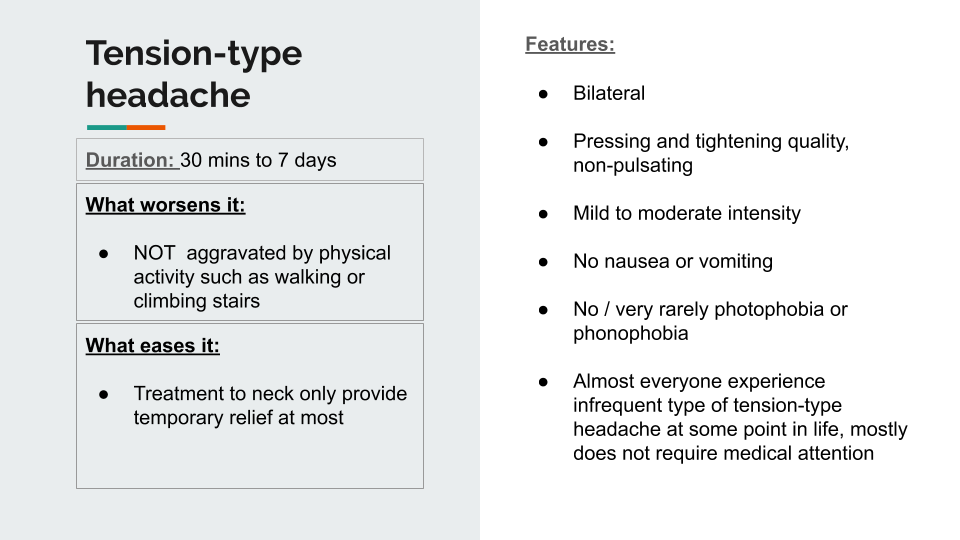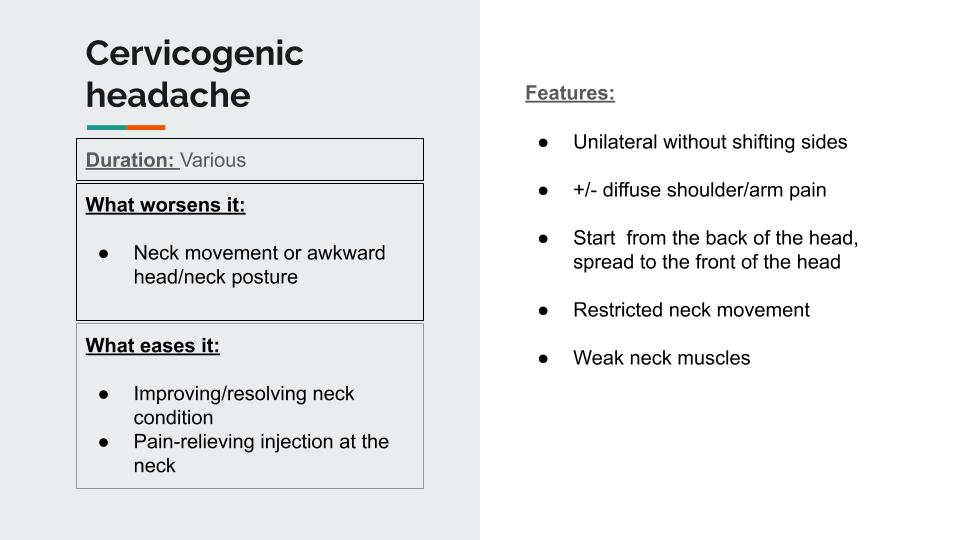
Do you know that headaches may cause neck discomfort, and neck problems can cause a headache too? This is because the nerves in the neck and the head are interconnected. When one end is irritated by mechanical (e.g. compression, concussion) or chemical (e.g. inflammation, chemicals released by nerves) causes, the other end may also feel the pain. Understanding which side was irritated in the first place helps plan effective treatment.
Headaches causing neck pain
Migraine and tension-type headache belong to the first category, i.e. headache causing neck discomfort. These two headache types are the most common among the over 300 headache types, and together they account for almost 50% of all headaches. Researches have shown that migraine is caused by disturbances in brain chemistry and blood vessels. Ongoing investigations also shed light on the relationship between tension-type headache and brain chemistry. While these headache types may cause neck stiffness or neck muscle tenderness, treatment to the neck will only provide temporary relief. Specific medications regulating nerve chemistry helps with migraine, while most tension-type headache will resolve spontaneously.
Neck pain causing headache
Cervicogenic headache (cervico = neck; genic=produced by), on the other hand, belongs to the second category. A Norwegian cross-sectional study showed that this headache type might affect 4% of the population. As the name describes, dysfunctions in neck structures, specifically from skull to the first, second and third neck spinal segment, may cause pain to be felt in the head. Examples of such dysfunctions include neck joint stiffness, neck muscle tension and neck nerve irritation. Patients with cervicogenic headache usually present with restricted neck movement and weak neck muscles (not commonly seen in patients with migraine and tension-type headache). Tackling the neck problem through joint mobilization, muscle training and in some severe cases, injection to neck structure, helps alleviate the referred pain to the head.
You may refer to the diagrams below for more information on migraine, tension-type headache and cervicogenic headache.
More than just headache or neck pain
That being said, there are two caveats to the above discussion:
1. Headache can be a symptom of many red flag conditions. If the headache bears the following quality / is associated with these symptoms (the list being non-exhaustive), one should seek medical help IMMEDIATELY for investigations to rule out any serious conditions.
- Very severe headache, worst pain ever
- Progressively worsening headache
- Headache which wakes a person up at night
- Headache type and the associated symptom changes
- Blurred / double vision
- Tenderness at the temple region
- Fever
- Weight loss
- High blood pressure
- Numbness
- Limb weakness
- Change in consciousness, drowsiness
- Neck rigidity
——————–
Reference:
Fredriksen, T. A., Antonaci, F., & Sjaastad, O. (2015). Cervicogenic headache: too important to be left un-diagnosed. In Journal of Headache and Pain (Vol. 16, Issue 1). Springer-Verlag Italia s.r.l. https://doi.org/10.1186/1129-2377-16-6
Hall T. (2017). Headache. In Peter Brukner P. , Khan K. (Eds.), Brukner & Khan’s Clinical Sports Medicine (5th ed., pp. 358-371). McGraw-Hill Education (Australia) Pty Ltd.
Lopez, A. D., Mathers, C. D., Ezzati, M., Jamison, D. T., & Murray, C. J. L. (2006). Global and regional burden of disease and risk factors, 2001: systematic analysis of population health data. In www.thelancet.com (Vol. 367). www.thelancet.com
Olesen, J. (2018). Headache Classification Committee of the International Headache Society (IHS) The International Classification of Headache Disorders, 3rd edition. In Cephalalgia (Vol. 38, Issue 1, pp. 1–211). SAGE Publications Ltd. https://doi.org/10.1177/0333102417738202
Rizzoli, P., & Mullally, W. J. (2018). Headache. In American Journal of Medicine (Vol. 131, Issue 1, pp. 17–24). Elsevier Inc. https://doi.org/10.1016/j.amjmed.2017.09.005


